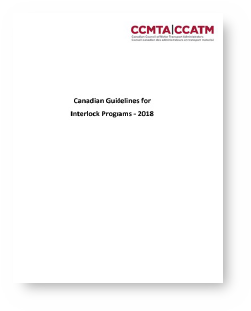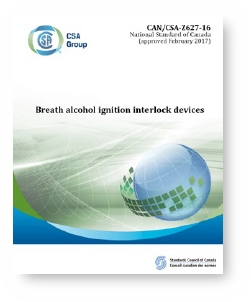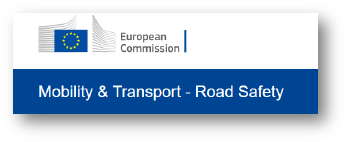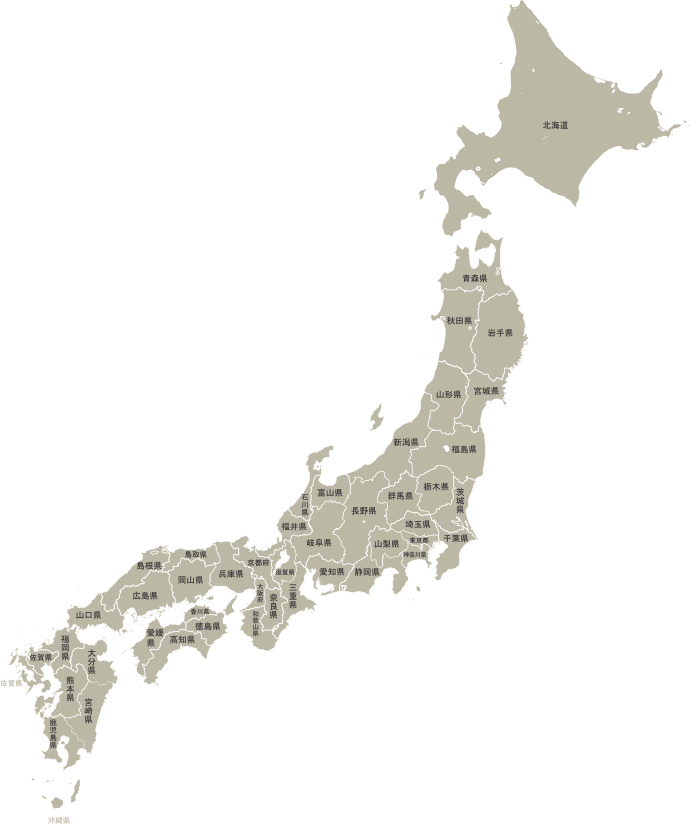アメリカ
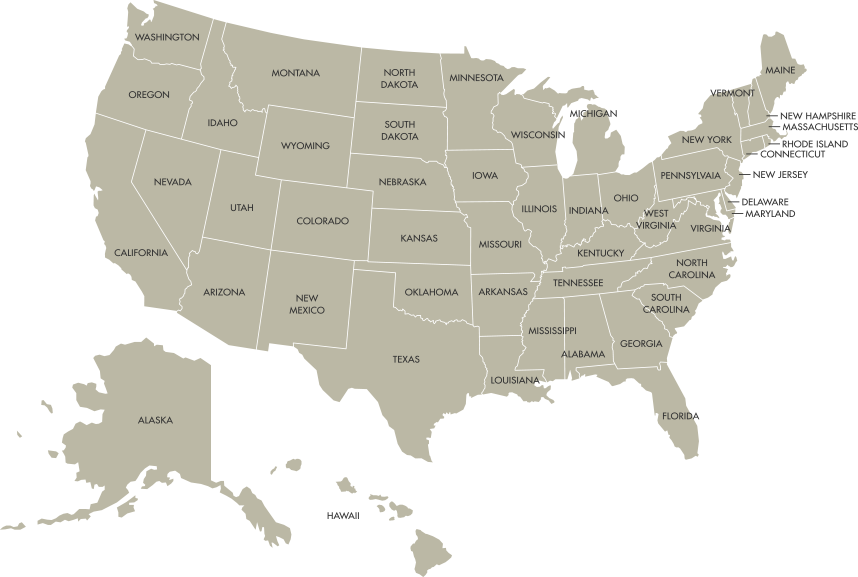
米国 アルコール・インターロック技術規格
アメリカは飲酒運転大国である。交通事故死者38,000人のうち、飲酒運転での死者は11,000人にも及ぶ。
飲酒運転をなくすため、20年以上も前からアルコール・インターロック制度が法制化され、今やほぼ全州で何らかのインターロック法が存在する。
アメリカは道路交通法や違反の罰金制度が州で違う。そのため、アルコール・インターロック法も40種類以上ある。
|
呼気吹き込み式 アルコール・インターロック装置の型式 Model specifications for breath alcohol ignition interlock devices |
1992Ver | 57 FR 11772 | https://archives.federalregister.gov/issue_slice/1992/4/7/11771-11787.pdf#page=2 |
|---|---|---|---|
| 2013Ver | 78 FR 26849 | https://www.federalregister.gov/documents/2013/05/08/2013-10940/model-specifications-for-breath-alcohol-ignition-interlock-devices-baiids |
アルコール・インターロックは型式定義はあるが、DOTの他のアルコール測定器(EBTやASD)にあるようなCPL(認定機器公表リスト)は策定されていないようである。
各州はメーカーによる自主的な適合評価シート(1992年版や2013年版等)をもとに、認定メーカーを指定していると思われる。
全米各州のアルコール・インターロック法制度
30の州とコロンビア特別区において初犯者をふくむすべての飲酒運転違反者にアルコール・インターロックの設置を義務付けている。
8の州(フロリダ、ミシガン、ミネソタ、ノースカロライナ、ペンシルバニア、ロードアイランド、サウスカロライナ、ワイオミング)では、高濃度の飲酒運転者、および再違反者へのアルコール・インターロックを義務づけている。
5つの州(ジョージア州、オハイオ州、マサチューセッツ州、メイン州、ミズーリ州)では、再違反者を繰り返すだけでデバイスをインストールできます。
7つの州(カリフォルニア、インディアナ、ネバダ、ノースダコタ、モンタナ、サウスダコタ、ウィスコンシン)には、アルコール・インターロックに関する州全体の要件はないが、裁判官は必要と判断した場合、飲酒運転違反者にアルコール・インターロックの設置を命じる裁量権を持っています。
| アラバマ | Alabama 1 Alabama 2 |
|---|---|
| アラスカ | Alaska |
| アーカンソー | Arkansas |
| カリフォルニア | California 1 California 2 |
| コロラド | Colorado 1 Colorado 2 |
| デラウェア | Delaware 1 Delaware 2 |
| フロリダ | Florida 1 Florida 2 Florida 3 |
| ジョージア | Georgia 1 Georgia 2 |
| ハワイ | Hawaii 1 Hawaii 2 |
| アイダホ | Idaho 1 Idaho 2 |
| イリノイ | Illinois |
| インディアナ | Indiana 1 Indiana 2 |
| アイオワ | Iowa |
| カンザス | Kansas |
| ケンタッキー | Kentucky 1 Kentucky 2 |
| ルイジアナ | Louisiana 1 Louisiana 2 |
| メーン | Maine 1 Maine 2 |
| メリーランド | Maryland 1 Maryland 2 Maryland 3 |
| マサチューセッツ | Massachusetts 1 Massachusetts 2 |
| ミシガン | Michigan 1 Michigan 2 |
| ミネソタ | Minnesota 1 Minnesota 2 Minnesota 3 |
| ミシシッピ | Mississippi 1 Mississippi 2 |
| ミズーリ | Missouri 1 Missouri 2 |
| モンタナ | Montana 1 Montana 2 |
| ネブラスカ | Nebraska 1 Nebraska 2 |
| ネバダ | Nevada 1 Nevada 2 |
| ニューハンプシャー | New Hampshire 1 New Hampshire 2 |
|---|---|
| ニュージャージー | New Jersey 1 New Jersey 2 |
| ニューメキシコ | New Mexico |
| ニューヨーク | New York 1 New York 2 |
| ノースカロライナ | North Carolina |
| ノースダコタ | North Dakota |
| オハイオ | Ohio |
| オクラホマ | Oklahoma 1 Oklahoma 2 |
| オレゴン | Oregon 1 Oregon 2 |
| ペンシルバニア | Pennsylvania 1 Pennsylvania 2 |
| ロードアイランド | Rhode Island 1 Rhode Island 2 |
| サウスカロライナ | South Carolina 1 South Carolina 2 |
| サウスダコタ | South Dakota |
| テネシー | Tennessee 1 Tennessee 2 |
| テキサス | Texas 1 Texas 2 |
| ユタ | Utah |
| バーモント | Vermont 1 Vermont 2 |
| バージニア | Virginia 1 Virginia 2 |
| ワシントン | Washington 1 Washington 2 Washington 3 Washington 4 |
| ウェストバージニア | West Virginia 1 West Virginia 2 |
| ウィスコンシン | Wisconsin 1 West Virginia 2 |
| ワイオミング | Wyoming 1 Wyoming 2 |
| ワシントンDC | District of Columbia(Washington,D.C.) |
アルコール・インターロック限定免許
アメリカには、「アルコール・インターロック限定免許」という制度があります。
-
【運転免許取得希望者へのリーフレット】
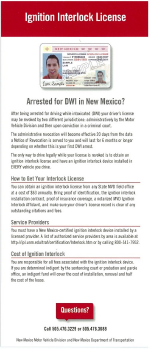
運転免許証を取得する時点で、飲酒運転の罰則としてアルコール・インターロックが装着されることを説明している。
-
【アルコール・インターロック限定運転免許証】
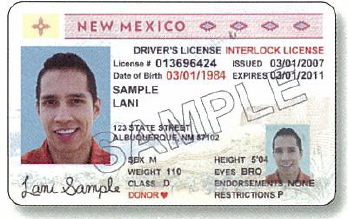
文字通りアルコール・インターロック装着車両しか運転できません。もし、アルコール・インターロックが装着されていないクルマを運転すると、無免許運転となり罰を受けます。
米国のアルコール・インターロック関連情報
-
●米国運輸省道路交通安全局
- 制度導入担当者向け、アルコール・インターロック入門
- https://www.nhtsa.gov/sites/nhtsa.gov/files/documents/ignitioninterlocks_811883_112619.pdf
-
●全米アルコール・インターロック管理者協会
- アルコール・インターロック法を施行する行政担当者を中心とした協会
- https://www.aiipaonline.org/
-
●アメリカのアルコール・インターロック アセスメント及び調査レポート集
-
●全米州議会議員会議
- 全州アルコール・インターロックについて
- https://www.ncsl.org/research/transportation/state-ignition-interlock-laws.aspx
-
●CDC米国疾病予防管理センター
- CDCによれば、アルコール・インターロックを装着している間、飲酒運転の再犯率は70%に抑えることができるという
- https://www.cdc.gov/transportationsafety/impaired_driving/ignition_interlock_states.html?CDC_AA_refVal=https%3A%2F%2Fwww.cdc.gov%2Fmotorvehiclesafety%2Fimpaired_driving%2Fignition_interlock_states.html
カナダ
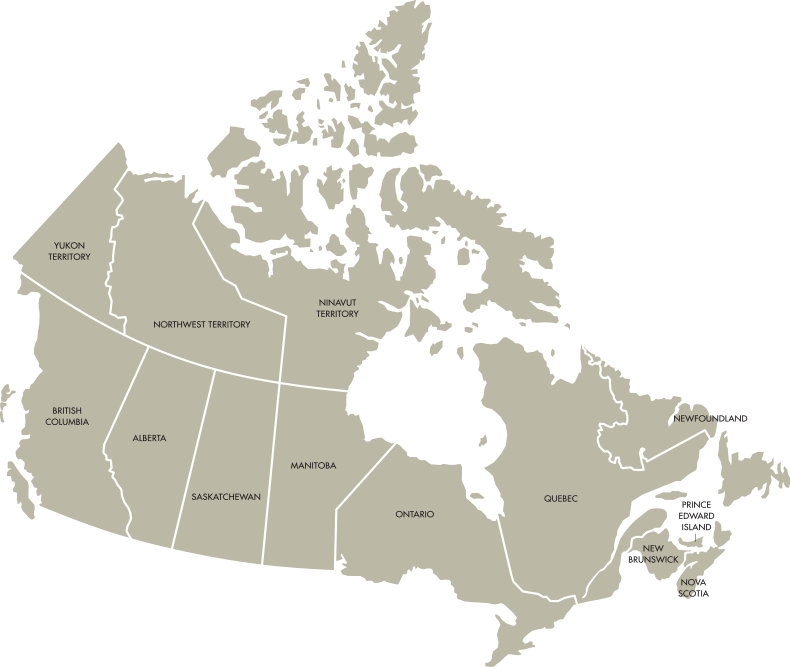
カナダの国土は広く、クルマなしでは生活が難しい国のひとつである。
カナダでは2008年以降、各州のアルコール・インターロック法が整備されてきた。
今や10の州すべてにおいて、アルコール・インターロック装着法が施行されている。
カナダのアルコール・インターロックの大枠
-
●カナダの運輸省が、アルコール・インターロック装置の法制度導入のガイドラインを定めている。
-
●カナダの国内規格団体により、アルコール・インターロック装置の技術文書が発行されている
-
●各州は、これらのtool kitを用いて、州ごとのアルコール・インターロック法制度(免許制度や刑法)を定めている
カナダ全州で
※以下の表は右にスクロールできます
オーストラリア

オーストラリアでは、死亡事故のうち16%が飲酒運転とされている。
各州政府は、2010年以前からアルコール・インターロック法を免許制度に取り入れてアセスメントし、現在もより効果性の高いものへとアップデートし続けている。
オーストラリアのアルコール・インターロックの総合政策
●道路交通安全 国家戦略2011-2020
There was some strengthening of drink driving measures over the decade, including adoption of tougher sanctions and the introduction of alcohol interlock programs for repeat or high-range offenders. However, while drink driving behaviour has been contained to a small proportion of the driver (and rider) population, it continues to be a major cause of serious road trauma — and there is evidence that a substantial proportion of drink drivers have serious alcohol abuse problems. In recent years there has been increasing focus on interventions targeting this ‘hard core’ minority of offenders.
New options based on advances in computing and sensor technologies have paved the way for new primary safety systems such as lane departure warning devices, collision avoidance warning and other advanced braking and driver management systems. There are also a number of vehicle safety technologies currently available or under development with the potential to target illegal driving behaviours, including Intelligent Speed Adaptation (ISA), alcohol interlocks, and seatbelt reminders and interlocks.
-
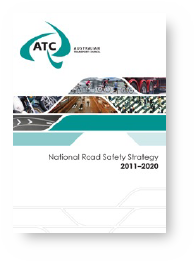
https://www.roadsafety.gov.au/sites/default/files/2019-11/nrss_2011_2020.pdf
-
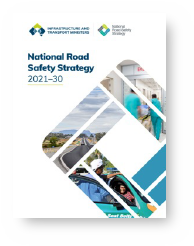
https://www.roadsafety.gov.au/sites/default/files/documents/National-Road-Safety-Strategy-2021-30.pdf
Alcohol interlocks
A substantial proportion of drink drivers — particularly recidivist offenders — are not responsive to mainstream deterrence measures due to serious alcohol abuse and broader social problems. Alcohol interlock programs have had some success in changing the behaviour of serious offenders. There is scope to extend the application of alcohol interlocks to cover a wider segment of the driver population, initially focusing on offenders and other higher-risk groups such as novice drivers. The majority of the community ride or drive responsibly, but may lapse occasionally. If the community supported the widespread implementation of alcohol interlocks, then in the next ten years drink driving could almost be eliminated. Some countries are creating initial markets to support the eventual widespread uptake of alcohol interlocks through fleets, in buses,taxis and trucks as a quality assurance action by responsible companies and employees.
36. In relation to alcohol interlocks:
a. Extend the application of alcohol interlocks to cover a wider segment of drink driving offenders. b. Undertake research on options to extend alcohol interlock applications to other high-risk road user groups and potentially to the broader driver population. c. Encourage voluntary use of alcohol interlocks by corporate fleets and other drivers. d. Investigate the option of requiring demonstrated rehabilitation from alcohol-dependence before removal of interlock conditions.
オーストラリア全州で
オーストラリア アルコール・インターロック関連情報
-
●National Road Safety Strategy 2011-2020
-
●Drink driving statistics
-
●National Road Safety Strategy
ヨーロッパ
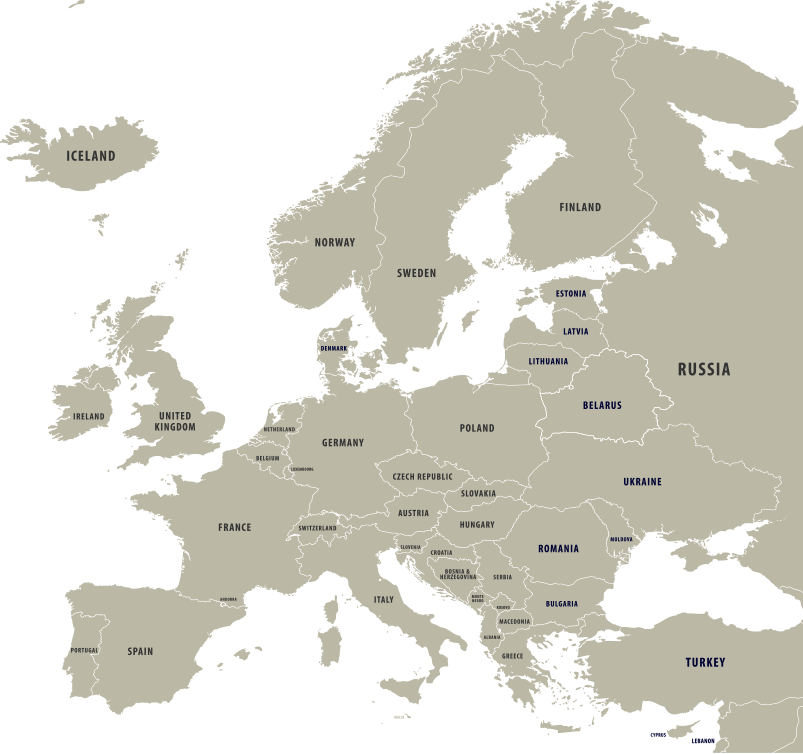
2019年、EU域内の飲酒事故死者は226,600人であったという。ヨーロッパの死亡事故のうち25%がアルコール絡みとされている。
EUは飲酒運転による死者を減少させるため、アルコール・インターロックを車両安全技術としてITS機器を位置づけ、各国へ導入を促している。
EUにおけるアルコール・インターロックの総合政策
●EUには、移動と輸送、道路交通安全に関連する総合政策委員会がある
加盟各国へ、事故防止のための先進的な車両安全基準の国内適用を促している。
アルコール・インターロックは、ABS、ADAS、ISA、シートベルトリマインダーとともに一般的な車両安全技術のひとつとして規定されている。
-
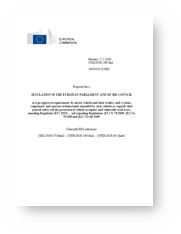
https://eur-lex.europa.eu/legal-content/EN/TXT/?uri=CELEX:52018PC0286
-
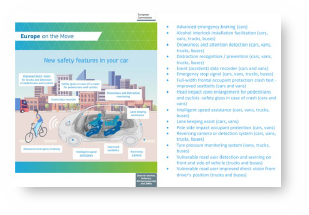
https://ec.europa.eu/docsroom/documents/29343
-
●ヨーロッパ各国の飲酒運転政策調査レポート

https://etsc.eu/wp-content/uploads/report_reducing_drink_driving_final.pdf
-
●ヨーロッパのアルコール・インターロック政策レポート
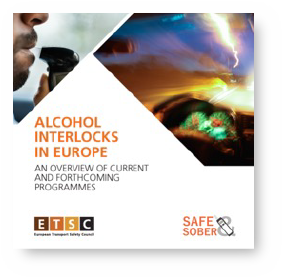
https://etsc.eu/wp-content/uploads/ALCOHOL_INTERLOCKS_FINAL.pdf
CENELECでのアルコール・インターロック 欧州規格
| EN-50436 Alcohol interlocks - Test methods and performance requirements | |||
|---|---|---|---|
| 規格 | Ver | 内容 | |
| EN 50436 | Part1 2014 |
飲酒運転違反者プログラムのためのアルコール・インターロック装置 Instruments for drink-driving-offender programs |
|
| EN 50436 | Part2 2015 |
マウスピースを用いた呼気計測による、予防的な使用向けアルコール・インターロック装置 Instruments having a mouthpiece and measuring breath alcohol for general preventive use |
|
| EN 50436 | Part3 2016 |
政府、行政、製造メーカー、購入者、使用者のためのガイダンス Guidance for authorities, decision makers, purchasers and users |
|
| prEN 50436 | Part4 2019 |
アルコール・インターロック装置と車両間の電気的な接続(コネクタ)とデジタル信号インターフェース Connection and digital interface between the alcohol interlock and the vehicle |
|
| prEN 50436 | Part5 | マウスピースや二酸化炭素補正を用いない、予防的な使用向けアルコール・インターロック装置 Instruments measuring breath alcohol for general preventive use, not having a mouthpiece and compensating by carbon dioxide measurement |
|
| prEN 50436 | Part6 2015 |
Data security | |
| prEN 50436 | Part72016 | Installation document | |
CENELECとは欧州電気標準化委員会
European Committee for Electrotechnical Standardizationのことである。
https://www.cencenelec.eu/
ヨーロッパでは、CENELECにより、「EN50436-XX」という番号でアルコールインターロック装置関連の標準化文書が発行されている。上記文書は、有償かつ著作権の問題があり、リンク先は購入サイトとなっている)
EU countries

- 9カ国(Finland,Sweden,Denmark,
Lithuania,Poland,Austria,Italy,France,
Belgium)が、違反者装着法制化 - 実績、約1万台くらいか
ヨーロッパ各国のアルコール・インターロック施行状況
※以下の表は右にスクロールできます
| Austria | Belgium | Denmark | Finland | France | Poland | Sweden | |
|---|---|---|---|---|---|---|---|
 |
 |
 |
 |
 |
 |
 |
|
| concept1 | Offender program | Offender program | Offender program | Offender program | Offender program | Offender program | Offender program |
| concept2 | Alcohol interlock combined with rehabilitation | Alcohol interlock combined with rehabilitation | Alcohol interlock combined with rehabilitation | Alcohol interlock combined with rehabilitation | Alcohol interlock as an alternative to suspension | Alcohol interlock as an alternative to suspension | Alcohol interlock combined with medical certificates |
| Relevant administration | Driving licence administration authorities (an operative coordinating institution (“ABS Institution”) has been created for the purpose of the trial) | Federal Public Service – Mobility & Transport | Danish Road Safety Traffic Authority | Finnish Transport and Communications Agency Traficom | French Prefecture | Swedish Transport Agency | |
| Trial | Pilot project 2012-2013 | 2005 | 2018: in seven french departments | 1999 | |||
| Entry into force | 2017 – 2022 (5 year trial) | Legislation came into force on 1 October 2010, but only operational since 2013 | 2015 – New programme in 2017 | 2008 | Extended to the entire country in 2019 | 2015 | 2012 |
| Position in the legal system | Administrative | Criminal | Administrative | Administrative until a judgement from the court | Criminal | ||
| How many ai installed today? | 150 - 200 installations per year | 757 (as of 20 October 2020) | 450 | Approximately 1,000 participants | Since 1 January 2020, and for the first 9 months, 8,104 prefectoral decrees restricting driving with an alcohol interlock have been proposed to offenders fined at the roadside by the police, leading to the effective installation of around 1500 devices. | While there is no data available of actual installed alcohol interlocks the number of court orders is available. However, this decision is not binding and the driver can still choose the licence suspension afterwards. • Offence – 94 in 2017, 303 in 2018, 21 in the 1st |
|
| WHO? | Offenders that volunteer based on the following criteria : • Only category B and BE • A suspension of the driving licence for at least four months • The expiration of at least half of the suspension period • No alcohol addiction |
• Repeat offenders with a BAC equal or above 1.2 g/l: judges must impose an alcohol interlock (1-3 years ), a driving ban (at least 3 months) and rehabilitation tests • First offenders with a BAC equal or above 1.8 g/l: judges must impose an alcohol interlock (1-3 years), unless clear justification • First offenders with a BAC equal or above 0.8 g/l or repeat offenders with a BAC above 1.2 g/l: judges may apply an alcohol interlock Possible exceptions: • Judge may exempt one or more vehicle categories • This has to be justified • Not possible to exclude vehicle category with which the traffic offence has been committed • No alcohol interlock for alcohol-dependent people (driving ban for medical or psychological reasons, art.42) • After the new law of 6 March 2018: judges use this art.42 more frequently |
• Voluntary programme: first time offenders with a BAC above 2 g/l, or second time offender with a BAC above 1.2 g/l In the voluntary programme the offender can participate from day one of the suspension of his driving licence. However, if the driver has caused personal injury or caused serious danger while driving, the driver can not participate in the programme. • Mandatory programme: second time offenders with a BAC level higher than 1.2 or first time offenders with a BAC level higher than 2.0. If it is the third offence or more, then the BAC level does not matter. In the mandatory programme the offender can participate when the suspension period is over, which is a minimum of three years |
• BAC 0.5 - 1.2 g/l : 12-36 months, median 16 months • BAC 1.2 g/l and above: 12-26 months, median 18 months To enter the programme the offenders have to send their application to the police. |
Offenders driving with a BAC above 0.8 g/l The alcohol interlock can be installed for a maximum duration of one year since May 2020 - it was previously six months (can be extended to five years by the judge at a later point) |
Offenders driving with a BAC above 0.5 g/l • 0.2-0.5 g/l (offence) • above 0.5 g/l (crime) Offenders may ask the court for their driving ban to be replaced with an alcohol interlock after at least half of the driving ban period has passed. If they had a lifetime driving ban they can apply for an alcohol interlock after at least 10 years. |
Possibility for drink drivers but not compulsory • 1 year programme for drivers convicted with a BAC level between 0.2 and 0.9 g/l; • 2 year programme for convicted repeat offenders (within a five- year period), and offenders with a BAC level of at least 1.0 g/l |
| Rehabilitation / Medical Aspects | The driver has to meet a mentor every two months • Examination of data readout for violations • Discussion of the participant‘s experience with the device Discussion of the driving behaviour in reference to the data readout and driver‘s logbook and development of strategies for a successful continuation of the programme • Support with administrative procedures in relation to the DUI offence • No mandatory medical or psychological examination (medical or psychological measures can be required in the revocation proceedings, in this case they have to be fulfilled before entering the alcohol interlock programme) |
Monitoring programme with awareness raising about the risks of alcohol, drink driving, recidivism and technical aspects of the device. Through data downloads the driver can learn more about their own behaviour (they won’t see the data by themselves but the monitoring entity will discuss the results regularly with them). Three recognised monitoring entities: VIAS Institute, Psycho Medisch Advies (since September 2018) and Noviter (since July 2019). |
Consultation compulsory in the voluntary programme | Requirement to meet a health care professional and get a certificate to be provided to the police | Following an alcohol interlock measure as an alternative to licence suspension, the prefecture's medical commission may issue an opinion to the prefect on the return of the driving licence, subject to certain conditions being met by the driver: • To install at their own expense an approved alcohol interlock in the vehicle they drive; • To carry out a medical-psychological follow-up i.e. an addiction consultation (follow-up is limited to this mandatory consultation, without any ongoing monitoring during the program and no data analysis) |
Under the Polish regulation, alcohol interlocks are not part of a rehabilitation programme. | The programme is not designed to include a rehabilitation aspect but, in many cases, it has shown these kinds of effects for the participants anyway. Especially since there is a demand to undergo medical exams, including leaving blood samples before, during and sometimes after participation in the programme. |
| Costs | Costs (approximate values) • 2,500 euros/year for the device • 600 euros minimum for the mentoring programme • 300 euros to install and remove the device |
• 1 year : 3 800 euros + Fine : 1,600-16,000 euros • Repeat offender: 3,200 - 40,000 euros - The judge can subtract the costs of the alcohol interlock from the fine |
Year 1: 2,400 euros Year 2: 1,920 euros Year 3: 1,440 euros |
• Purchase : 1,300 euros • Rent : 100 euros/month The installation and operating costs of the device are the responsibility of the driver. The price of installation and dismantling in the vehicle must be added. To facilitate the installation of the devices the french road safety website provides users with a national map of approved installers by department and region.9 |
Costs • 1 year : 2,000 – 2,700 euros • 2 years : 2,800 – 4,000 euros |
||
| Gender/Age | • 87% male • Average age: 45-54 years old |
• Average age: 51 years old • 84% male |
• 87% male • Average age: 45-54 years old |
||||
| Participation rate | • No general participation rate can be identified because there are no figures available of how many are eligible. • It can be said that once a candidate is in contact with the ABS institution there is a participation rate of nearly 99% |
85% of participants completed the programme | • 30% of offenders entered the programme • 83% of participants completed the programme • 31 % of participants had an alcohol-related diagnosis Due to an infringement procedure from the EU the new legislation in force as of March 2018 does not allow offenders with a dependency or an addiction to enter the alcohol interlock program in Sweden, unless they can prove that they fulfil all the medical demands beforehand, e.g. prove sobriety six months prior to entering the programme. |
||||
| Evaluation | No official evaluation yet (Evaluation planned after the trial period ends in 2022) | The evaluation led to a change in the legislation adopted on the 6th of March 2018: judges are no longer free to decide • In case of a BAC above 1.8 (they have to give a reason as to why they don’t impose an alcohol interlock), and • In case of severe recidivism (≥1.2BAC) (no exception with a reason is possible), but in every case judges have the possibility to limit to certain vehicle categories (except the vehicle category with which the offence was committed). • Exception: no alcohol interlock if the offender is alcohol dependent (in this case there is a license withdrawal for physical or psychological reasons). |
When implementing the programmes the Danish National Police had expected an annual number of participants of between 500 and 1,000. However, an evaluation showed that there were only 24 participants in the alcohol interlock program. This led to a change of the voluntary programme in 2017: before 2017 an alcohol interlock could replace a licence suspension of maximum two years, now three years of suspension can be replaced with three years with an alcohol interlock. Today approximately 450 drivers are participating in an alcohol interlock programme. | Completed in 2013 • 1,687 drivers • Average duration: 17 months • 5.7% of the drivers reoffended during or after the probation period whereas the usual recidivism rate for drink-driving offenders is 30% • The alcohol interlocks have prevented 12,000 participants from driving under the influence of alcohol |
No evaluation planned yet but several improvements have been made: • This alcohol interlock programme was decided as an alternative to a driving licence suspension in order to improve the existing judicial system as it was felt that the obligation to drive with an alcohol interlock was coming too late in the process. • In order to combat recidivism, a measure from 9 January 2018, makes it compulsory to install an alcohol interlock in the event of a repeat offence of driving under the influence of alcohol. |
There are no studies monitoring the effects of implementing this solution. | Completed in 201811 About 3,000 people are currently driving with an alcohol interlock |
ETSCが、ヨーロッパのアルコールインターロックプログラムの制定状況を詳しく報告している。
https://etsc.eu/issues/drink-driving/alcohol-interlock-barometer/
アジア

アジアにおいても、道路交通法規や運輸行政を改正し、アルコール・インターロックの社会実装をしようという動きが出ている。
台湾
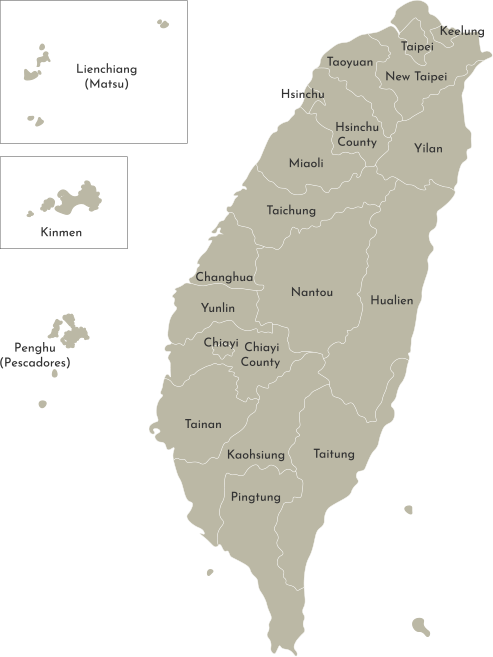
台湾のアルコール・インターロック法制化
●台湾では、2020年に飲酒運転違反者へのアルコール・インターロック装着を法制化した。
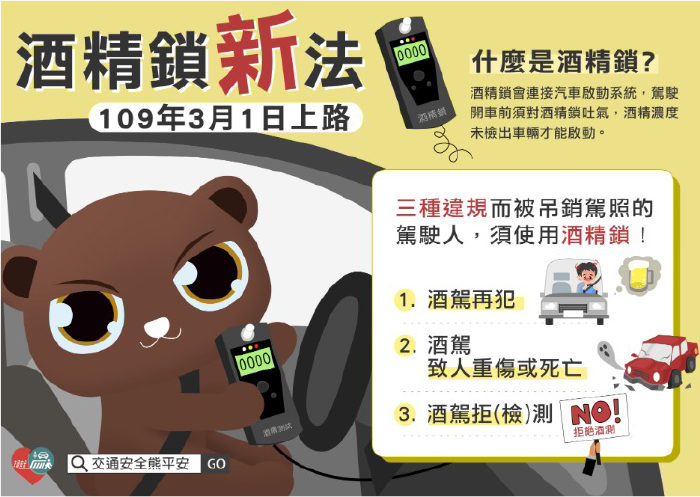
●台湾のアルコール・インターロック 法制化文書
-
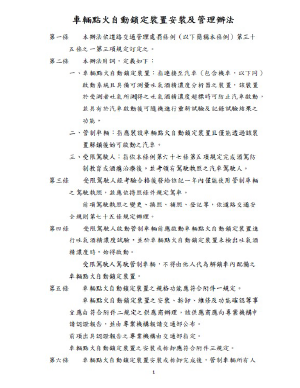
車輛點火自動鎖定裝置
安裝及管理辦法 -
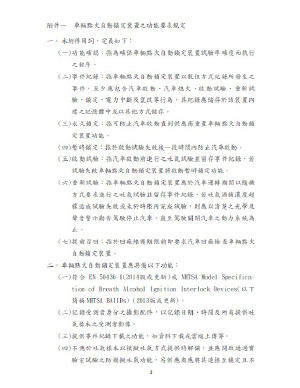
附件一
車輛點火自動鎖定裝置之功能要求規定 -
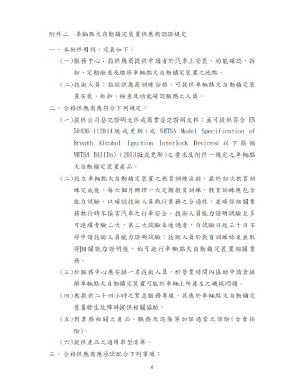
附件二 車輛點火自動鎖定裝置
供應商認證規定 -
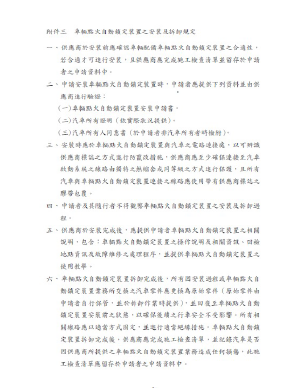
附件三 車輛點火自動鎖定
裝置之安裝及拆卸規定 -

附件四 車輛點火自動鎖定
裝置之定期檢查及維修規定
●EVバスの購入補助金支給の「智能化」要件
韓国
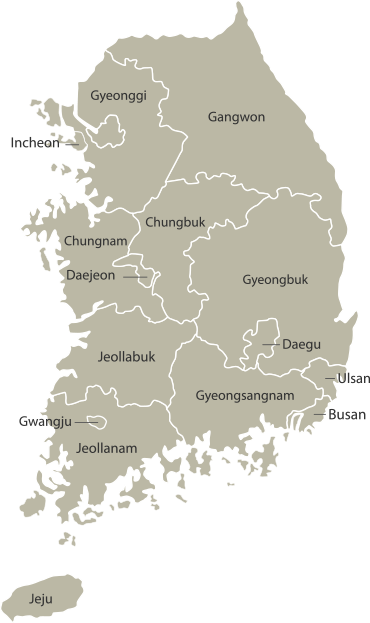
●韓国においてもアルコール・インターロック装置法制化(違反者向け)の動きがある。
2017年頃に飲酒運転防止のためのアルコール・インターロック導入が国会に法案提出されたが、廃案となった模様。
2017年2月28日 国会提出 議案番号:2005842
道路交通法の一部改定法律案
議案番号(2005842) 代表発議者 宋喜卿
■ 提案理由及び主要内容
飲酒運転は習慣的に繰り返される傾向があり罰金額の増額と懲役刑期間の延長等、処罰の水準を強化する事後的処置だけではその限界があるため、飲酒運転を予防できる事前的処置が必要である。
近年新技術の発展により飲酒運転防止装置(運転者が酒酔い状態で運転をしようとする場合、酔いが検知され始動できないようにする装置)が開発され注目を集めていることから、 効果的な飲酒運転予防装置の導入を考慮する必要がある。
飲酒運転等で運転免許の取り消し処分が下された者が再び運転免許を取得し自動車等を運転する際は運転免許証が発行された日から一定期間飲酒運転防止装置が設置された自動車のみを運転するべきこととし、これを違反した場合、1年以下の懲役または300万ウォン以下の罰金に処することで、飲酒運転再発防止に万全を期することとする。(案第44条の2及び第152条の1号の2の新設)
2020年5月29日 本会議結果:任期満了廃案
<東海電子による調査・翻訳>
2017年7月17日 国会提出議案番号:2005842
自動車管理法の一部改定法律案 代表発議者 閔丙梪
■ 提案理由及び主要内容
貨物自動車、貸切バス等の大型車両の運転者や、路線バスやタクシーのような公共交通の運転者が飲酒運転による事故を起こす場合、多数の死傷者が発生するなど、社会的に大きな人的・物的被害を起こしているため、これらを予防する為の具体的な方案を設ける必要がある。
フランスの場合、2010年1月1日以後、新規で登録されたバスや子供の通学バスに飲酒始動ロック装置(運転者が酒に酔った状態で自動車を運転しようとする場合、酔いを検知し始動できないようにする装置をいう)を装着して運用しており、2015年9月1日からはすべてのバスに飲酒始動ロック装置の装着を義務化している。
貨物自動車、タクシー、バス(貸切バスを含む)等、大統領令にて定める自動車の運転者は飲酒始動ロック装置を義務的に設置して運行することとし、自動車の製作・販売者等による該当車両に飲酒始動ロック装置を設置して販売するようにし、大型車両の運転者や公共交通の運転者の飲酒運転を事前に防止しようとすることである。
また陸上運送業、公共交通の運転(路線バス、タクシー)等に従事している人々の飲酒運転を未然防止することで持続的な経済活動を営むようにするためである。(案第29条の4新設、第84条の第1項、第84条の第3項の第2号の2新設)
2020年5月29日 本会議結果:任期満了廃案
2018年11月8日 国会提出議案番号:2016452
租税特例制限法の一部改定法律案 代表発議者 金寬永
■ 提案理由及び主要内容
最近5年間の飲酒運転取締の件数は毎年平均26万件で、中小都市の全人口に当たるほどの大きな規模であり、それによる人命被害と経済的損失が莫大なものである。また5年の間 3,750名が死亡、飲酒運転による年間被害額は 8,100億ウォン以上で推定されている。
故に憲法第34条の国民が保護を受ける権利を保障し、財産及び人命被害を減らすために飲酒運転の前科のない、一般運転者にも飲酒始動ロック装置(運転者が酒に酔った状態で自動車等を運転しようとした場合、酔いを検知して始動ができないようにする装置をいう)の装着を勧奨しようとする。
故に「道路交通法」第93条の第1号から第3号までのいずれに該当して運転免許の取り消し処分を受けていない運転者の自発的に飲酒始動ロック装置の設置の場合は、飲酒始動ロック装置の購入時に付加価値税の免除範囲に含め、道路交通安全を拡散しようとする。(第106条の第1項の13号新設)
2020年5月29日 本会議結果:任期満了廃案
<東海電子による調査・翻訳>
2019年2月15日 国会提出議案番号2018657
交通安全法の一部改定法律案 代表発議者 金寬永
○交通交通法の一部改正法律案 2018657号(韓国語原文)
○交通交通法の一部改正法律案に対する国土交通委員会の検討会文書(日本語訳)
○交通交通法の一部改正法律案に対する国土交通委員会の検討会文書(韓国語)
2019年6月7日 国会提出議案番号:2020877
自動車管理法の一部改定法律案 代表発議者 金映豪
■ 提案理由及び主要内容
飲酒運転に対する制裁を強化するユン・チャンホ(人名)法が通過されたが、未だに飲酒運転が後を絶たない。
飲酒運転は事故発生時大きな人命被害が起きる。特に子どもの通学バス等のような乗客を乗せて運行するバスは事故発生時、多くの人命被害が発生するなどその被害は非常に大きい。
フランスは2010年に子どもの通学バスに運転者の飲酒状態を確認してから始動できる飲酒運転防止装置を義務化しており、2015年にはすべてのバスへと義務化を拡大している。
子どもの通学バス等の旅客用の自動車を運転する場合、飲酒運転を根本的に防ぐ必要がある。故に「旅客自動車の運輸事業法」により旅客の運輸に用いられる自動車の中から大統領令にて定める自動車の運転者は飲酒運転防止装置を設置して自動車を運行するようにする。(案第29条の4、第84条の第1項の第2号及び第84条の第3項の第13号の2新設) 2020年5月29日 本会議結果:任期満了廃案



